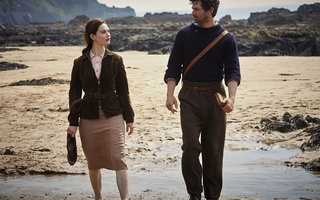Shakespeare has undeniably stood the test of time, but the question remains: Can he stand the test of the ballet? This Valentine’s Day, an endless sea of couples flooded the Wang Theatre for the opening night of the Boston Ballet’s “Romeo and Juliet,” featuring original staging by the legendary South African choreographer John Cranko and Prokofiev’s stunning score. Despite a slow and emotionally unengaged beginning, the performance eventually redeems itself and proves that Shakespeare’s famous “star-cross’d lovers” can hold their own—even in pointe shoes.
Cranko’s ballet, which premiered in 1962 with the Stuttgart Ballet in Germany, begins on the streets of Verona, where Romeo (Nelson Madrigal) pines over Rosalind as his cousins bite their thumbs—or, rather, kick their legs—at the Capulets. The set transforms to reveal the interior of a ballroom, where Romeo and Juliet (Larissa Ponomarenko) first meet. Sadly, the precious moment in the text where Romeo absolves his sins on Juliet’s lips, then kisses her again to retrieve them, is sacrificed. The act closes with the famous balcony scene, lacking in both passion and a balcony, as Romeo athletically hangs from the edge of a bridge-like structure as the lovers’ lips lock. While moving at points, the first act proves more expository than expressively riveting. The hour, in essence, is a talent show, providing the landscape for the story but not the emotion. In the streets of Verona, where the two families play out their feud, the dancers remain in boring clumps as soloists take the center—an altogether too benign opening to such an epic tragedy.
From Act Two on, the production makes a complete turn-around, as the back scrim becomes a tornado’s sky, foreboding and infinite, and Cranko’s characteristically modernist aesthetic finally takes hold, replacing the traditional grandiose set with bleak minimalism. Swords clink to the beat of the music as Tybalt (Yury Yanowsky) kills Mercutio (Reyniers Reyes) and Romeo kills Tybalt. Both death scenes are heart-wrenching, reminding us that there are no clear victories and no concrete enemies in the world of Shakespeare. Equally as heart-wrenching is the scene in which Juliet consumes the Friar’s potion. Here, Cranko takes full liberty from the Bard and brings in eight ballerinas bearing white flowers. As they dance around Juliet’s bed, Prokofiev’s score adopts the innocent chimes of carousel music, serving as effective contrast with the subsequent discovery of Juliet’s body and Lady Capulet’s grief.
In the final scene, Cranko’s staging successfully rejuvenates an age-old ending to which modern audiences are inevitably desensitized. Rather than featuring two of the fastest, most un-thought-over suicides in history, the scene is drawn-out and painful, making it the most reverent of the Shakespearean tragedy in the ballet. When Juliet awakes to find her lover’s dead body beside her, she instinctively wraps her legs and arms around him and rocks him back and forth. Their bodies meld into one another, transcending the line between life and death, as she dances with his limp form. It’s as if her spirit dies at the sight of Romeo, and the knife is just an afterthought. The visceral nature of “Romeo and Juliet,” it turns out, transcends the spoken word and can be effectively expressed through the art of dance.
While the dancing often falls subject to the narrative, especially in the expository first act, the expressive quality of both the gothic and modern sets, the swelling, cinematic score, and Cranko’s choreography effectively revamp an age-old story.
Read more in Arts
Be Kind RewindRecommended Articles
-
Newly-Formed Shakespeare Group To Present 'The Play's the Thing'The Dean's office late yesterday approved plans of the newly organized Harvard Shakespearian Players to present "The Play's the Thing,"
-
No HeadlineJunior theme 3 will be due in Sever 3 today at 2 o'clock. Subjects: A Summary of one of the
-
The Bard Reloaded and Remixed with Gothic TwistFrom “two star-crossed lovers” all the way through “for never was a tale of such woe…” most everyone is familiar
-
Hyperion Escapes Early DemiseUnlike star-crossed lovers and Danish princes seeking revenge, the recently resurrected Hyperion Shakespeare Company is getting a second chance after
-
 ‘The Guernsey Literary and Potato Peel Pie Society’ A Warm and Delightful Period Drama
‘The Guernsey Literary and Potato Peel Pie Society’ A Warm and Delightful Period Drama













